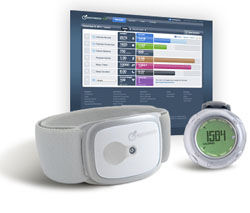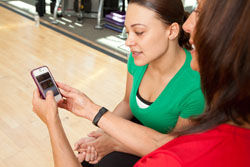
By Lance Dalleck, Ph.D.
JOIN THE CONVERSATION!
What technologies do you recommend to your clients? Which products or apps do you find to be most effective in helping your clients stay motivated and active? Share your thoughts and recommendations in the comments section below.
Improvements in technology have brought about marked reductions in the physical work required as part of daily life. In fact, technological advancements in the Digital Age (the last two generations) have almost completely eliminated most previously required physical activities. The systematic displacement of a physically active lifestyle in our natural outdoor environment with a sedentary, indoor lifestyle is the root of many of increasingly prevalent chronic diseases such as diabetes and heart disease. In the March 2012 issue of ACE Certified News, we offered examples on how to replicate indigenous human-activity patterns to the extent that this is possible and practically achievable in today’s society. An alternative approach is to use technology itself to increase physical activity (Macri, Young and Kahn, 2010). Research has shown that pedometers, video games (such as Wii Fit) and mobile phone applications can each be used to increase energy expenditure. Here are five practical ideas for implementing technology to help clients increase their daily physical-activity levels.
Active Video Games
Technological advancements have led to dramatic increases in the time both children and adults spend in sedentary, screen-based activities such as watching TV, using computers and the Internet, and playing video games. These screen-based activities are thought to displace more active and healthy behaviors. Screen-based activities have also been linked to hypertension, obesity and cardiovascular disease (Foley and Maddison, 2010). Interventions focused on reducing screen-time have been largely unsuccessful because, frankly, people enjoy these activities and don’t want to give them up. Accordingly, researchers have begun to formulate novel—and often effective—interventions that utilize screen-based technology as part of the solution to physical inactivity (Biddiss and Irwin, 2010).

Active video games make it possible for players to physically interact via arm, leg or whole-body movements with images onscreen in a variety of activities and sports, including boxing, dancing, tennis, skiing, soccer and walking. Popular active video games in recent years include Dance Dance Revolution, Nintendo Wii and Wii Fit, Sony Eye Toy and Xerbike. Research has focused on how these types of active video games can be used to increase energy expenditure and improve various components of fitness.
In general, studies have shown that active video games can be employed to increase daily energy expenditure levels (Primack et al., 2012). One study of middle-age and older adults concluded that playing Wii Fit video games is a feasible alternative to more traditional aerobic exercise, and that doing so meets industry guidelines for improving and maintaining cardiorespiratory fitness (Guderian et al., 2010).
Research in children has also been shown to positively modify body composition (Foley and Maddison, 2010), and it has also been reported that Wii Fit video games can be used to safely improve balance in older adults (Agmon et al., 2011).
Bottom Line
Active video games can be powerful tools in helping clients increase their activity levels. Fitness professionals should consider using active video games as a programming option for increasing activity levels in certain client types.
Activity Trackers and Pedometers
An activity tracker (also called an accelerometer) is an instrument generally worn on either the trunk or limbs that measuresduration, frequency and intensity of physical activity; this measurement is obtained by quantifying the acceleration and deceleration of the body. While single-plane accelerometers measure movement in the vertical plane, triaxial plane accelerometers measure movement in the horizontal, mediolateral and vertical planes. The gathered values are recorded and then downloaded to a computer for analysis and interpretation. The primary advantages of activity trackers are that they are small, light-weight and usually non-cumbersome. Moreover, physical activity data can be recorded over prolonged periods of time, ranging from several days to even weeks.

From an economic perspective, the use of activity trackers can be hindered by the cost of the instrument, as well as the expense of the software and hardware required to analyze recorded data. Activity trackers also have some specific limitations in certain situations. For instance, single-plane accelerometers do not permit measurement of activities such as bicycling or weight lifting. Furthermore, both single and triaxial accelerometers are unable to detect increases in upper-body movement (e.g., upper-body resistance training), increased energy expenditure resulting from carrying a load (e.g., backpack) or alterations in energy expenditure due to changes in surface type (e.g., walking uphill or walking in snow). Additionally, the equations used to estimate energy expenditure from the movement recorded by activity trackers are based on data collected in the laboratory; accordingly these equations may not always provide a valid estimate of energy expenditure for those activities performed in real-life situations.
Pedometers, on the other hand, sense vertical accelerations of the body—a step is recorded when these vertical accelerations surpass a threshold value. These instruments are small, light-weight and non-invasive to wear for most individuals. Moreover, they are typically cost-effective and, with proper instruction, pedometers are easy to use. Pedometers also offer the advantage of providing immediate feedback to the user.
Paradoxically, although there is not a wealth of detailed scientific evidence supporting their effectiveness, pedometers have experienced a surge in popularity as an instrument for motivating and monitoring physical activity in the past decade. Many current guidelines recommend taking 10,000 steps per day. Yet, for some years it was not known whether performing 10,000 steps per day was associated with significant improvements in health outcomes. A relatively recent review on this issue reported that use of pedometers is associated with significant increases in physical activity (Bravata et al., 2007). Moreover, it was found that using a pedometer was linked to decreases in body mass index and blood pressure. Nevertheless, it was noted in this review that whether or not these favorable health changes persist long-term still remains unknown.
There are a number of limitations in the use of pedometers, most notably for assessing energy expenditure, as most inexpensive pedometers do not have the capacity to determine duration, intensity and type of physical activity. Furthermore, many pedometers may not be sensitive enough to detect steps in certain populations, including obese and older, frail individuals. For these reasons, it has been suggested that pedometers not be used to quantify energy expenditure of exercise.
Despite these limitations, however, the pedometer is still a practical—and inexpensive—device for determining activity levels and for quantifying changes in physical activity over time by tracking and recording changes in the number of steps taken each day.
Bottom Line
The list of commercially available pedometers and activity trackers is lengthy, and it can be challenging to know which ones are worth recommending to your clients. In general, most pedometers are accurate for assessing steps, less accurate for assessing distance and even less accurate for assessing energy expenditure. Activity trackers offer a wide range of features, some of which may or may not appeal to every individual.
The ACE Product Review site includes detailed reviews of a number of pedometers and activity trackers. While some clients can benefit from a simple and inexpensive pedometer, others might prefer the more detailed data provided by products from companies like BodyMedia, Nike or FitBit.
Smartphones

The technology of mobile phones has changed dramatically over the past few years. Original simple call-and-text devices have evolved into sophisticated mini-personal computers known as smartphones. In fact, you might be surprised to learn that mobile phones are now more prevalent than computers or Internet access around the world. Moreover, smartphones are the most rapidly growing subset of the mobile phone market. The list of available applications (apps) has grown dramatically as well. As of 2010, there were more than 17,000 health- and fitness-related smartphone applications available, and some predict that 500 million people will be using these types of smartphone applications by 2015 (Kirwan et al., 2012).
Given that the typical smartphone user spends approximately 80 minutes per day using smartphone applications, there is a tremendous potential for these devices to assist in the promotion of numerous positive, healthy behavior changes, including increased physical activity. Indeed, preliminary research on the use of smartphone technology to self-monitor physical activity has shown promise. One study found that existing members of a website-delivered activity program (10,000 Steps, Australia) who installed the application on their smartphone and used it for three months were more likely to take more than 10,000 daily steps (and record the results) than members of the control group who did not have the smartphone application. Researchers concluded that having the smartphone application increased the quality and duration of engagement in the intervention due to the increased convenience of the smartphone application (Kirwan et al., 2012).
The list of commercially available pedometers and activity trackers is lengthy, and it can be challenging to know which ones are worth recommending to your clients. In general, most pedometers are accurate for assessing steps, less accurate for assessing distance, and even less accurate for assessing energy expenditure. Activity trackers offer a wide range of features, some of which may or may not appeal to every individual.
The ACE Product Reviewsite includes detailed reviews of a number of pedometers and activity trackers. While some clients can benefit from a simple and inexpensive pedometer, others might prefer the more detailed data provided by products from companies like BodyMedia, Nike or FitBit.
Bottom Line
How can you help your clients take advantage of smartphone application technology? First, don’t look at smartphone applications as a possible replacement of the expertise you offer to your clients. On the contrary, smartphone applications hold enormous potential to augment delivery of your expertise and services. For instance, applications such iFitness can assist your clients after they have begun training with you. This application features pictures, videos and proper instruction on hundreds of exercises, which can help clients check their form when they are following your recommended program on their own. Your clients might also benefit from nutrition-based apps, such as Eat This, Not That! Restaurants, which can help them make healthier choices when eating out.
One last word of caution though on the use of health- and fitness-related applications. Not surprisingly, research suggests that application content does not always adhere to evidence-based guidelines. For example, a recent review of iPhone applications to help people stop smoking found that they rarely adhered to established guidelines for smoking cessation (Abroms et al., 2011). In other words, always do your research before recommending an application to a client to be sure the content is valid and in alignment with best practices.
Web-based Exercise Programs and Health Sites

Internet use is greater than 65 percent in most industrialized countries and increasing rapidly, and Internet users are becoming more representative of the overall population, including more women, older adults, and people with lower socioeconomic status and educational attainment. Website-delivered physical-activity interventions and trackers have been shown to be effective in that they provide a solution to many of the traditional barriers to exercise, including lack of time or money. The Internet is also an important source of health- and fitness-related information for more than half of all users (Vandelanotte et al., 2007). However, the sheer volume of information available on the Internet is beyond mind-boggling. For example, a Google search on the phrase ‘health and fitness’ yields 165 million results. Knowing how to decipher fact from fiction, reality from myth and/or evidence-based scientific recommendations from personal bias can be challenging, even for well-educated fitness professionals. Here are a few tips to share with your clients to make them better consumers of website health- and fitness-related content:
- Is the website content current and evidence-based? In other words, is the information presented by the author or organization founded on scientific research findings from the past five or 10 years? If not, consider looking elsewhere.
- What are the credentials of the author in terms of professional experience and/or education? Is the organization publishing the information for-profit or not-for-profit? Another important consideration is whether or not the content has been peer-reviewed, which means an independent individual or group of experts reviewed it for accuracy before it was published online.
Bottom Line
The Internet has made it easy to find an answer to just about any question one could possibly ask. The validity of that answer, however, largely depends on the source. Urge your clients to use the information they find on the Internet wisely and with caution, and encourage them to come to you when they have health- or fitness-related questions.
Heart-rate Monitors
There is considerable range in the overall capability (and cost) of different models of heart-rate monitors. While some devices simply display heart rate in real time, others record heart rate for prolonged periods of time. Furthermore, some models permit setting target heart-rate ranges and will alert the user when heart rate falls below or exceeds established lower or upper heart-rate limits.

Heart-rate monitors can be used to estimate energy expenditure because of the significant relationship that exists between the two. Accordingly, these devices can predict the energy expenditure associated with various durations, intensities and frequencies of physical activity. However, the validity of these energy expenditure estimates is likely to be affected by several factors. First, there is considerable inter-individual variance for the relationship between heart rate and energy expenditure; for instance, the increase in caloric expenditure for a given increase in heart rate will differ across individuals. Moreover, increases in heart rate can be elicited by non-physical activityrelated components. Emotion, hydration status and environmental factors, such as temperature, humidity and altitude, increase heart rate independent of physical activity. Nonetheless, research suggests that heart-rate monitors are reasonably accurate, and there is evidence that heart-rate monitoring may be as accurate as indirect calorimetry in measuring the energy expenditure of activities of daily living (Crouter et al., 2004) Other more recent advancements in wearable technologies include the Zephyr BioHarness, which also provides data on heart rhythm (i.e., electrocardiogram).
Bottom Line
Exercise intensity is arguably the most critical component of your clients’ exercise programs. Failure to meet minimal threshold values may result in lack of a training effect, while exercising at an inappropriately high intensity could lead to overtraining and negatively impact adherence to the exercise program (Guderian et al., 2010). Heart-rate monitors are a simple, yet excellent, example of how technology can be used to increase the safety and effectiveness of your clients’ exercise programs.
Fitness Tech to Boost Your Business:
Body Monitoring Devices & More (Recorded Webinar)
Interested in learning more about how technology can help your clients become more physically active? This recorded webinar will show you how technology like body monitoring devices and smartphone applications can give you a better understanding of your client’s lifestyle and how you can improve their progress through targeted advice. In this webinar, you’ll get an expert’s take on some of the more popular products on the market, including the pros and cons of each. You’ll also learn which devices provide the most useful feedback, as well as different methods for using data to promote client success, create challenges and offer enhanced services for data review.
This webinar is worth 0.1 CECs and can be accessed at any time from the comfort of your home. For more information, click here.
References
Abroms, L.C. et al. (2011). iPhone apps for smoking cessation: A content analysis. American Journal of Preventive Medicine, 40, 279–285.
Agmon, M. et al (2011). A pilot study of Wii Fit exergames to improve balance in older adults. Journal of Geriatric Physical Therapy, 34, 161–167.
Biddiss, E. and Irwin, J. (2010). Active video games to promote physical activity in children and youth: A systematic review. Archives of Pediatric and Adolescent Medicine, 164, 664–672.
Bravata, D.M. et al. (2007). Using pedometers to increase physical activity and improve health: A systematic review. Journal of the American Medical Association, 298, 2296–2304.
Crouter, S.E. et al. (2004). Accuracy of polar S410 heart rate monitor to estimate energy cost of exercise. Medicine & Science in Sports & Exercise, 36, 1433–1439.
Foley, L. and Maddison, R. (2010). Use of active video games to increase physical activity in children: A (virtual) reality? Pediatric Exercise Science, 22, 720.
Guderian, B. et al. (2010). The cardiovascular and metabolic responses to Wii Fit video game playing in middle-aged and older adults. Journal of Sports Medicine and Physical Fitness, 50, 436–442.
Kirwan, M. et al. (2012). Using smartphone technology to monitor physical activity in the 10,000 Steps program: A matched case-control trial. Journal of Medical Internet Research, 14, e55.
Macri, E.M., Young, V.C. and Khan, K.M. (2010). Can exercise advice be ‘made to stick’? Combining psychology and technology to improve patient uptake of physical activity prescription. British Journal of Sports Medicine, 44, 993.
Primack, B.A. et al. (2012). Role of video games in improving health-related outcomes: A systematic review. American Journal of Preventive Medicine, 42, 630–638.
Vandelanotte, C. et al. (2007). Website-delivered physical activity interventions: A review of the literature. American Journal of Preventive Medicine, 33, 54–64.
__________________________________________________________________
 Lance C. Dalleck, Ph.D., is academic coordinator of the cardiac rehabilitation postgraduate program at the University of Auckland in New Zealand. His research interests include improving exercise performance and health outcomes through evidence-based practice, quantifying the energy expenditure of outdoor and non-traditional types of physical activity, and studying historical perspectives in health, fitness and exercise physiology.
Lance C. Dalleck, Ph.D., is academic coordinator of the cardiac rehabilitation postgraduate program at the University of Auckland in New Zealand. His research interests include improving exercise performance and health outcomes through evidence-based practice, quantifying the energy expenditure of outdoor and non-traditional types of physical activity, and studying historical perspectives in health, fitness and exercise physiology.